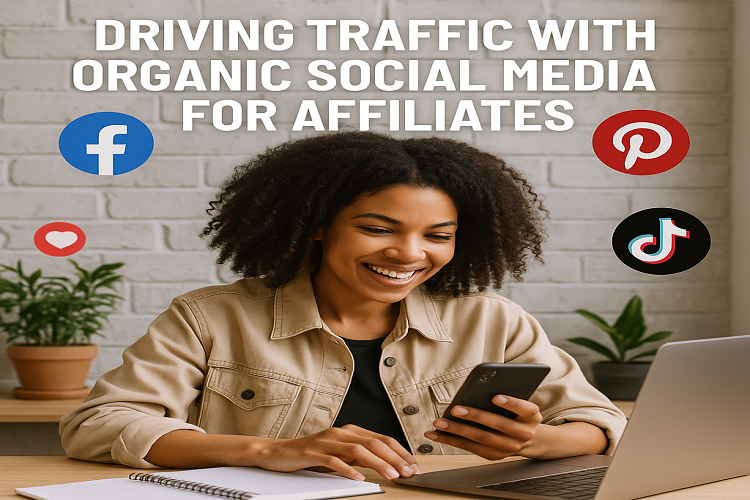The Power of Organic Traffic
You don’t need a massive ad budget to succeed with affiliate marketing. In fact, some of the most successful affiliate marketers generate the bulk of their traffic from organic social media. No pay-per-click, no boosted posts just strategy, creativity, and consistency.
Organic social media marketing isn’t just free it’s also highly targeted, builds trust, and creates lasting engagement. In this guide, we’ll break down how to drive affiliate traffic using Facebook, Pinterest, TikTok, and other major platforms all without spending a dime.
1. Picking the Right Platforms
Every affiliate strategy should begin with knowing where your audience hangs out. Each social media platform has a unique style, demographic, and traffic behavior.
- Best for: Long-form content, link sharing, groups, and communities.
- Tactics: Create a branded Page, join niche Groups, share value-first posts with affiliate mentions or blog links.
- Ideal niches: DIY, parenting, finance, health, outdoor living, tech.
- Best for: Visual storytelling, evergreen content, link-driving posts.
- Tactics: Create vertical pins with compelling CTAs, link to blogs with embedded affiliate links.
- Ideal niches: Recipes, fashion, decor, wellness, how-tos.
TikTok
- Best for: Viral, short-form video content.
- Tactics: Tutorials, product demos, “Things I Bought and Love” series with subtle affiliate promos.
- Ideal niches: Tech, lifestyle, fitness, beauty, gadgets.
Bonus Platforms:
- Instagram: Visual + short-form stories, reels for brand building.
- YouTube Shorts: Video reviews with cloaked affiliate links in the description.
- Twitter/X: Great for tech, news, finance, and rapid engagement.
2. Creating Engaging, Shareable Posts
It’s not just what you post it’s how you post it. For affiliate marketing, your goal is to provide value first, then offer a solution through your affiliate link.
What Works:
- “Before and after” visuals (esp. in health, beauty, DIY)
- Quick tips that solve a real problem
- Short reviews or reactions to products
- Storytelling: “I tried [X Product] so you don’t have to…”
What Doesn’t Work:
- Posting links without context
- Generic promotional posts
- Keyword stuffing hashtags
- Overloading posts with CTAs
Post Framework for Affiliates:
Hook: Grab attention in the first 2 seconds.
Story/Tip: Offer value or share a result.
CTA: “Learn more here” or “This helped me, maybe it will help you too” (link follows).
Use tools like Canva or InVideo to quickly create scroll-stopping visuals and reels even without experience.
3. Leveraging Niche Groups & Communities
One of the biggest untapped goldmines in affiliate marketing is social groups. Whether on Facebook, Reddit, or Discord, communities are built around shared interest and where there’s interest, there’s intent.
How to Strategically Join Groups:
- Choose groups aligned with your niche (e.g., “Beginner Gardening” or “Off-Grid Living”)
- Be an active contributor: answer questions, share tips, post helpful content
- Avoid link-dropping until you’re trusted
- Instead, link to helpful blog content that has your affiliate offers inside
⚠️ Never join just to spam your links build trust first, monetize second.
Bonus Tip:
Start your own group or community. As the admin, you can pin posts with your content, run giveaways with affiliate sponsors, and turn followers into buyers.
4. Scheduling vs. Real-Time Engagement
Both automation and live interaction have their place in an affiliate strategy. The key is balancing consistency with authenticity.
Use Scheduling Tools For:
- Batch posting content for the week
- Sharing your best blog content or affiliate reviews
- Managing multiple platforms at once
Tools to Try:
- Buffer – Easy multi-platform scheduling
- Later – Especially great for Instagram/Pinterest
- Metricool – For analytics + automation combo
Make Time for Real-Time:
- Comment back within the hour for boosted visibility
- Join trends or challenges in your niche
- Go live occasionally to show your face and earn trust
Affiliate sales come faster when you feel real to your followers.
5. Avoiding Platform Policy Pitfalls
Each social platform has its own rules when it comes to affiliate marketing and breaking them can get your account shadowbanned or worse, deleted.
General Rules of Thumb:
- Disclose affiliate links clearly (“This link earns me a small commission…”)
- Avoid link shorteners that look suspicious
- Don’t pretend a recommendation is unbiased if it’s paid
- Don’t spam DMs or comment sections with affiliate links
Specific Platform Notes:
| Platform | Can you post affiliate links directly? | Notes |
| Yes (with disclosure) | Better to link to blog content | |
| Only in bio/Stories (unless Shopify store) | Use “Link in bio” tools | |
| Yes | Make sure links resolve correctly | |
| TikTok | No direct links in captions | Use Linktree or blog redirects |
| YouTube | Yes (in descriptions) | Add FTC disclosure in video or caption |
If unsure, link to a blog post that contains your affiliate link. This improves SEO and keeps you safe.
Go Organic, Grow Smart
Affiliate marketing doesn’t require a giant ad budget it needs hustle, value, and presence.
By focusing on organic social media traffic, you’ll not only generate free leads, but also build a reputation that pays off long-term. Pick your platforms wisely, engage with your tribe, and always focus on helping before selling.
This is the slow burn that leads to lasting income.
✅ Action Steps:
- Choose 1 platform to master this week
- Create 3 value-first posts promoting a product or article
- Join 5 niche groups and start contributing daily
- Use a tool like Buffer to schedule content for the next 7 days
Affiliate Disclaimer Example:
Some of the links in this post are affiliate links. If you click and make a purchase, we may earn a small commission at no additional cost to you. We only recommend products we genuinely love.

